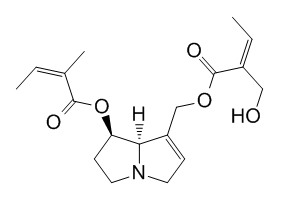Triangularine
Triangularine is a natural product from Senecio triangularis.
Inquire / Order:
manager@chemfaces.com
Technical Inquiries:
service@chemfaces.com
Tel:
+86-27-84237783
Fax:
+86-27-84254680
Address:
1 Building, No. 83, CheCheng Rd., Wuhan Economic and Technological Development Zone, Wuhan, Hubei 430056, PRC
Providing storage is as stated on the product vial and the vial is kept tightly sealed, the product can be stored for up to
24 months(2-8C).
Wherever possible, you should prepare and use solutions on the same day. However, if you need to make up stock solutions in advance, we recommend that you store the solution as aliquots in tightly sealed vials at -20C. Generally, these will be useable for up to two weeks. Before use, and prior to opening the vial we recommend that you allow your product to equilibrate to room temperature for at least 1 hour.
Need more advice on solubility, usage and handling? Please email to: service@chemfaces.com
The packaging of the product may have turned upside down during transportation, resulting in the natural compounds adhering to the neck or cap of the vial. take the vial out of its packaging and gently shake to let the compounds fall to the bottom of the vial. for liquid products, centrifuge at 200-500 RPM to gather the liquid at the bottom of the vial. try to avoid loss or contamination during handling.
Sci Rep. 2017, 8207(7)
Int J Mol Sci.2023, 24(20):15320.
Evid Based Complement Alternat Med.2021, 2021:5023536.
Academic J of Second Military Medical University2019, 40(1)
Anticancer Res.2024, 44(3):1033-1044.
Applied Biological Chemistry2021, 64(4)
Mol Plant Pathol.2023, 24(2):123-141.
Food Science and Biotechnology2023, 2023:1007
National Academy Science Letters2023, s40009.
Sci Rep.2023, 13(1):21690.
Related and Featured Products
Journal of Natural Products,1991 ,54 (3).
Gc-ms Determination of Pyrrolizidine Alkaloids in Four Senecio Species[Reference:
WebLink]
METHODS AND RESULTS:
Four Senecio species were analyzed by gc-ms for their pyrrolizidine alkaloid content. This is the first published report of pyrrolizidine alkaloids in Senecio serra, Senecio dimorphophyllus, and Senecio hydrophyllus. Previously undetermined pyrrolizidine alkaloids from Senecio mikanioides were also tentatively identified. Gc-ms analyses showed the presence of the stereoisomers senecionine {9} and integerrimine {11} in S. dimorphophyllus and complex mixtures of monoester and diester pyrrolizidine alkaloids in the other three species. Tentative structural identifications were made of ten new pyrrolizidine alkaloids. These new alkaloids are isomers of Triangularine, sarracine {13}, 7-angelylplatynecine {5}, 7-angelylretronecine {2a}, and acetylated macronecine-type alkaloids.
CONCLUSIONS:
All three species contained both saturated and unsaturated pyrrolizidine alkaloids, and all had at least ten individual alkaloids. The mass spectral features and gc elution order of these compounds are discussed and the pyrolizidine alkaloid profiles of the plants are compared. The potential toxicity of the three species to range animals is discussed.



